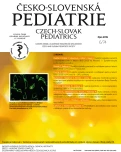False positivity in newborn screening of 21-hydroxylase deficiency
Authors:
J. David; M. Hedelová; F. Votava
Authors‘ workplace:
Klinika dětí a dorostu, Fakultní nemocnice Královské Vinohrady a 3. lékařská fakulta Univerzity Karlovy, Praha
Published in:
Čes-slov Pediat 2019; 74 (6): 354-358.
Category:
Original Papers
Overview
In single ventricle patients, hemoptysis is a life-threatening complication. Development of hemoptysis is associaObjective: False positive rate (FPR) in 21-hydroxylase deficiency screening tests is the highest of all screened diseases in the Czech Republic. The aim of this study was to evaluate the FPR for 17-hydroxyprogesterone (17OHP) decision limits based on gestational age and birthweight.
Methods: The study included 129,175 newborns in Bohemian region during the period 2015–2017. 17OHP was analysed using the immune-analytic method (AutoDELFIA® PerkinElmer by Wallac Oy, Finland). 411 newborns have been screened as positive newborns. FPR was compared by statistic method Adjusted Wald interval for a difference of proportions with matched pairs (Software R program).
Results: The diagnosis of 21-hydroxylase deficiency was confirmed in eighteen patients, 393 findings were false positive. Our study showed a statistically significant reduction of FPR using 17OHP decision limits based on gestational age with same sensitivity.
Conclusion: The evaluation of 17OHP decision limits based on gestational age reduced FPR and could decrease impacts on healthy part of population.
Keywords:
Birth weight – congenital adrenal hyperplasia – 21-hydroxylase deficiency – gestational age – 17-hydroxyprogesterone – false positivity
Sources
1. Speiser PW, Azziz R, Baskin LS, et al. Congenital adrenal hyperplasia due to steroid 21-hydroxylase deficiency: an Endocrine Society Clinical Practice Guideline. J Clin Endocrinol Metab 2010; 95 (9): 4133–4160.
2. Dunnen JT, Dalgleish R, Maglott DR, et al. HGVS Recommendations for the description of sequence variants: 2018 Update. Hum Mutat 2018; 37: 564–569.
3. David J, Vinohradská H, Dejmek P, et al. Epidemiologické hodnocení výsledků novorozeneckého screeningu kongenitální adrenální hyperplazie v České republice. XII. Český pediatrický sjezd s mezinárodní účastí, Hradec Králové, 15. –17. 9. 2016. Abstrakt in: Čes-slov Pediat 2016; 71 (Suppl1): 42–43.
4. Van der Kamp HJ, Wit JM. Neonatal screening for congenital adrenal hyperplasia. Eur J Endocrinol 2004; 151 (Suppl 3): U71–75.
5. Metodický návod k zajištění novorozeneckého laboratorního screeningu a následná péče. Praha: Ministerstvo zdravotnictví ČR, 2016; 11: 1–6.
6. Minutti CZ, Lacey JM, Magera MJ, et al. Steroid profiling by tandem mass spectrometry improves the positive predictive value of newborn screening for congenital adrenal hyperplasia. J Clin Endocrinol Metab 2004; 89 (8): 3687–3693.
7. Frankova V, Votava F, Kožich V. Etické aspekty rozšiřování novorozeneckého screeningu dědičných metabolických poruch. Čes-slov Pediat 2014; 69: 87–94.
8. ÚZIS. Rodička a novorozenec. Praha: ÚZIS. http://www.uzis.cz/en/category/tematicke-rady/newborns.
9. ČSÚ. Obyvatelstvo. https://www.czso.cz/csu/czso/population.
10. Blankenstein O, Stopsack M, Fingerhut R, et al. The ISNS 17OHP initiative: Establishing of 17OHP cut-off levels by international collaboration. The 6th European Regional Meeting in Neonatal Screening, Praha, 26.–28. 4. 2009. Čes-slov Pediat 2009; 64 (4): 192–193.
11. Votava F, Kozich V, Chrastina P, et al. Performance metrics of 5 years of newborn screening in the Czech Republic. Int J Neonatal Screen 2016; 2: 69–70.
12. Tsuji A, Konishi K, Hasegawa S, et al. Newborn screening for congenital adrenal hyperplasia in Tokyo, Japan from 1989 to 2013: a retrospective population-based study. BMC Pediatr 2015; 15: 209.
13. Heather NL, Seneviratne SN, Webster D, et al. Newborn screening for congenital adrenal hyperplasia in New Zealand, 1994–2013. J Clin Endocrinol Metab 2015; 100 (3): 1002–1008.
14. Steigert M, Schoenle EJ, Biason-Lauber A, et al. High reliability of neonatal screening for congenital adrenal hyperplasia in Switzerland. J Clin Endocrinol Metab 2002; 87 (9): 4106–4110.
15. Anandi VS, Shaila B. Evaluation of factors associated with elevated newborn 17-hydroxyprogesterone levels. J Pediatr Endocrinol Metab 2017; 30 (6): 677–681.
16. Gruñeiro-Papendieck L, Prieto L, Chiesa A, et al. Neonatal screening program for congenital adrenal hyperplasia: adjustments to the recall protocol. Horm Res 2001; 55 (6): 271–277.
17. Slaughter JL, Meinzen-Derr J, Rose SR, et al. The effects of gestational age and birth weight on false-positive newborn-screening rates. Pediatrics 2010; 126 (5): 910–916.
18. Van der Kamp HJ, Oudshoorn CG, Elvers BH, et al. Cutoff levels of 17-alpha-hydroxyprogesterone in neonatal screening for congenital adrenal hyperplasia should be based on gestational age rather than on birth weight. J Clin Endocrinol Metab 2005; 90 (7): 3904–3907.
19. Torresani T, Grüters A, Scherz R, et al. Improving the efficacy of newborn screening for congenital adrenal hyperplasia by adjusting the cut-off level of 17α-hydroxyprogesterone to gestational age. Screening 1994; 3 (2): 77–84.
20. Cavarzere P, Camilot M, Teofoli F, et al. Neonatal screening for congenital adrenal hyperplasia in North-Eastern Italy: a report three years into the program. Horm Res 2005; 63 (4): 180–186.
21. Fiet J, Le Bouc Y, Guéchot J, et al. A Liquid chromatography/Tandem Mass Spectometry Profile of 16 serum steroids, including 21-deoxycortisol and 21-deoxycorticosterone, for management of congenital adrenal hyperplasia. J Endocr Soc 2017; 1 (3): 186–201.
Labels
Neonatology Paediatrics General practitioner for children and adolescentsArticle was published in
Czech-Slovak Pediatrics

2019 Issue 6
Most read in this issue
- The problem of an early diagnostic procedure in neuroinfection – case report
- Functional results of patients with cleft palate between 1993 and 2006 in Moravia I – Epidemiology and surgical results
- False positivity in newborn screening of 21-hydroxylase deficiency
- Antibody-mediated rejection in children after kidney transplantation
